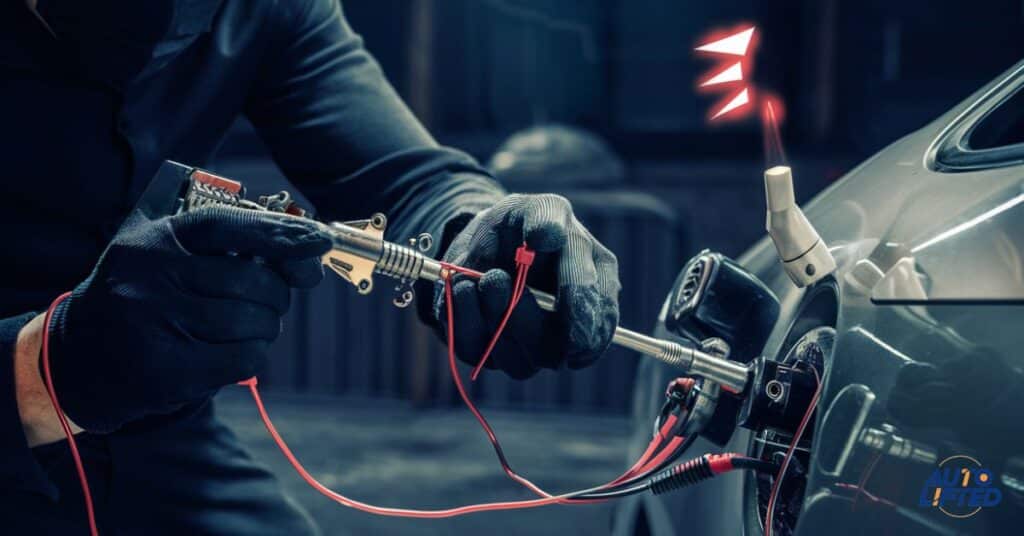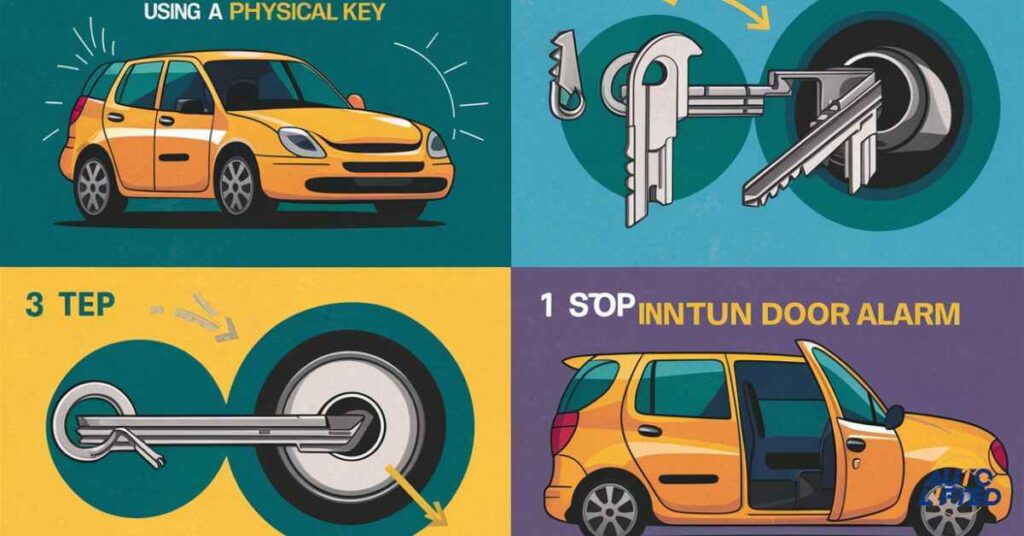Before we dive into the methods to stop a car alarm without a key, it’s crucial to understand how these systems work. Cars typically come equipped with either factory-installed or aftermarket alarm systems. Both are designed to deter thieves by emitting loud, shrieking sounds when triggered by motion sensors, door sensors, or other security breaches.
Factory-installed car alarm systems are integrated into the vehicle during manufacturing, and they often communicate with a key fob or the physical key itself. Aftermarket alarms, on the other hand, are third-party systems installed after purchase, and they may not always be compatible with the car’s existing keys.
Regardless of the type of alarm system, it’s essential to familiarize yourself with its components and mechanisms. Understanding how your specific alarm system operates can make the process of deactivating it without a key much smoother.
The Physical Key Approach

If you find yourself faced with a blaring car alarm and no functioning remote, your first course of action should be to utilize your physical key. This method is particularly effective for factory-installed alarm systems, as the key is often programmed with a chip code that communicates with the vehicle.
Try using your physical key to unlock and lock the doors
Insert the key into the driver’s side door lock and turn it to unlock the door. If the alarm continues to sound try locking and unlocking the door a few times. In many cases, this simple action may be enough to deactivate the alarm system.
Read This Blog:
How Long Does It Take To Put Tint On A Car
If unsuccessful, insert the key into the ignition and turn it on
Once you’ve gained access to the interior of your vehicle, the next step is to attempt to deactivate the alarm by turning on the ignition. Insert the key into the ignition switch and turn it to the “ON” position. This action may interrupt the alarm sequence and bring an end to the incessant noise.
Real-life example: Jessica, a busy mom, found herself in a frustrating situation when her car alarm went off unexpectedly while she was juggling groceries and her kids. With no key fob in sight, she remembered this simple trick from her owner’s manual.
She inserted her physical key into the driver’s side door, unlocked and relocked it a few times, and like magic, the alarm stopped its blaring. Relief washed over her, and she could finally proceed with her day without disturbing the entire neighborhood.
Step-by-Step Guide to Using the Physical Key

Using the physical key to stop a car alarm is a straightforward process that begins with locating your car’s key. Insert the key into the driver’s side door lock and turn it to unlock the door. If the alarm continues, try locking and unlocking the door a few times to see if this resets the system.
Next, enter the vehicle and insert the key into the ignition. Turn the key to the “ON” position or start the engine, which often disarms the alarm. If these steps do not work, refer to your vehicle’s owner’s manual or seek professional assistance to resolve the issue.
Unlocking the Driver’s Side Door with the Key
Unlocking the driver’s side door with the key is a crucial first step in deactivating a car alarm without a remote. Begin by inserting the key into the door lock and turning it to the unlock position. This action can sometimes reset the alarm system and stop the noise immediately.
If the alarm persists, try locking and unlocking the door several times. This process can help to communicate with the car’s alarm system, signaling it to deactivate. Ensure you are using the correct key and that it is fully inserted into the lock for optimal results.
Using the Key in the Ignition to Silence the Alarm
Using the key in the ignition is an effective method to silence a car alarm when the remote is unavailable. Start by entering the vehicle and inserting the key into the ignition switch. Turn the key to the “ON” position, which often interrupts the alarm sequence and stops the noise.
If the alarm continues, proceed to start the engine by turning the key further. This action can reset the car’s alarm system and deactivate the alarm. If these steps do not work, refer to your vehicle’s owner’s manual for specific instructions or seek professional assistance.
Troubleshooting Common Issues with the Physical Key Approach
Troubleshooting common issues with the physical key approach starts with ensuring the key is not damaged or worn out. A damaged key may not fully engage the lock mechanism, preventing it from deactivating the alarm. If the key appears fine, check the door lock for any obstructions or damage that might impede its function.
If the alarm still doesn’t turn off, the issue might be with the car’s alarm system or the key’s electronic chip. Some cars have immobilizers that require a properly coded key to deactivate the alarm. In such cases, you might need to reprogram the key or consult a professional mechanic for further diagnosis and assistance.
Alternative Door Manipulation Techniques

If the standard key approach doesn’t work, there are a few other door manipulation techniques you can try. Some car alarms are equipped with door sensors, making these methods a potential solution for silencing the alarm.
- Sequence of turns with the key in the door lock: Try inserting the key into the driver’s door lock and performing a specific sequence of turns, such as two turns to the right followed by two turns to the left.
- Holding the key in the lock for a few seconds: Alternatively, hold the key in the driver’s door lock for a few seconds before rotating it to open the door. These maneuvers may trick the alarm system into deactivating.
However, it’s essential to exercise caution and follow the manufacturer’s recommended methods to avoid damaging your vehicle or causing further issues.
Also Read This Blog:
How Long Does It Take To Import A Car From Japan
Disconnecting the Battery
If all else fails, disconnecting the car battery can serve as a last resort to stop the alarm. This method should be approached with caution and only attempted if you’re familiar with the process and potential risks.
Step-by-Step Guide:
- Pop open the hood of your vehicle and locate the battery.
- Using a wrench, loosen the nut on the negative terminal of the battery and remove the cable.
- Allow a minute or two to pass before reconnecting the cable.
This action should disrupt the power supply to the alarm system, causing it to reset and cease its blaring. However, keep in mind that disconnecting the battery may also reset other vehicle settings, such as radio presets, clock, and personal preferences.
Important Note: While this method can be effective, it should only be used as a temporary solution. If your car alarm continues to activate persistently, it’s best to seek professional assistance to identify and address the underlying issue.
Consulting the Owner’s Manual

Every vehicle is unique, and the best source of guidance on how to deactivate your specific car alarm lies within the owner’s manual. Refer to the manual for detailed instructions tailored to your vehicle’s make and model.
If you’re unable to locate your physical manual, many manufacturers provide digital copies online for easy access. Simply search for your car’s make, model, and year, and you should be able to find the relevant information.
The owner’s manual may also include additional manufacturer-recommended methods for disabling the alarm, such as locating an override switch or performing a specific sequence of actions.
Handling Aftermarket Alarms
If you have an aftermarket car alarm installed, resolving alarm issues without a remote or key may require additional steps. Aftermarket alarm systems often lack compatibility with standard car keys, making manual deactivation challenging.
In such cases, reaching out to the manufacturer for guidance or referring to the alarm system’s documentation becomes crucial. Alternatively, seeking assistance from a professional mechanic who specializes in automotive security systems may be necessary.
Preventing Future Alarm Issues

While knowing how to stop a car alarm without a key is essential, it’s equally important to take preventive measures to minimize the occurrence of false alarms or persistent activations.
Tips for minimizing accidental alarm activations:
- Ensure all vehicle openings (doors, trunk, windows) are securely closed before locking your car.
- Adjust the sensitivity settings of the alarm system, if possible, to reduce the likelihood of false triggers from vibrations or minor movements.
- Regularly maintain and service your car alarm system to ensure proper functionality.
Additionally, if you’ve lost or damaged your key fob, consider obtaining a replacement or having your existing remote reprogrammed by an authorized dealer. This can help prevent future incidents where you’re left without a functional remote.
When to Seek Professional Help
While the methods outlined in this guide can be effective in many situations, there may be instances where seeking professional assistance is the best course of action.
Signs that indicate the need for professional diagnosis and repair:
- Your car alarm continues to activate persistently, even after trying multiple deactivation methods.
- You suspect an underlying electrical or mechanical issue is causing the alarm to malfunction.
- You’re unsure about the specific components or mechanisms of your alarm system.
Consulting a mechanic or an authorized dealer can provide you with expert guidance and ensure that any underlying issues are properly diagnosed and resolved. Attempting complex repairs or modifications to your vehicle security system without the necessary expertise can potentially cause further damage or compromise the system’s effectiveness.
Key Takeaways:
- Try using your physical key to unlock and lock the doors or turn on the ignition.
- Explore alternative door manipulation techniques if the key approach doesn’t work.
- Disconnecting the battery can be a temporary solution but should be done cautiously.
- Consult the owner’s manual or access digital copies online for vehicle-specific instructions.
- Reach out to the manufacturer or seek professional help for aftermarket alarms or persistent issues.
- Implement preventive measures like adjusting sensitivity settings and obtaining replacement remotes.
- Seek professional diagnosis and repair if the alarm continues to activate persistently or you suspect underlying issues.
Frequently Asked Question
What button do you press to stop a car alarm?
To stop a car alarm, press the lock or alarm button on your key fob. If the remote is not working, using the physical key in the door lock might help.
Will car alarms eventually stop?
Yes, most car alarms will stop after a few minutes if left unattended, but this can vary depending on the vehicle’s alarm system.
How do I stop my car alarm from turning off when I use the key?
To prevent the alarm from turning off, ensure you’re using the correct key and try inserting it into the driver’s side door lock or ignition to reset the system.
How do I deactivate my anti-theft system?
To deactivate your anti-theft system, insert your key into the ignition and turn it to the “ON” position, or follow specific instructions in your vehicle’s owner’s manual.
How do I deactivate my car alarm?
You can deactivate your car alarm by using the key fob, inserting the key into the driver’s side door lock, or turning the ignition to the “ON” position.
How to stop a car alarm manually?
To stop a car alarm manually, use the physical key in the driver’s side door lock, turn the ignition on, or disconnect the car battery temporarily.
Conclusion
Dealing with a blaring car alarm without a key can be a frustrating and stressful experience, but with the right knowledge and approach, it doesn’t have to be. By understanding your specific alarm system, utilizing the physical key, or exploring alternative methods like disconnecting the battery or consulting the owner’s manual, you can regain control and restore peace of mind.
Remember, while these methods can provide temporary relief, it’s important to prioritize safety and follow manufacturer guidelines. If you encounter persistent issues or suspect underlying problems with your alarm system, don’t hesitate to seek professional assistance.
Familiarizing yourself with your car’s alarm system, taking preventive measures, and knowing when to seek expert help can go a long way in ensuring a hassle-free and secure driving experience.







